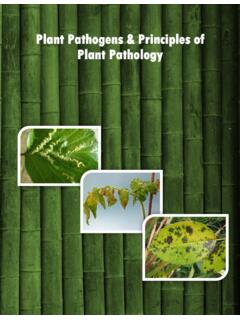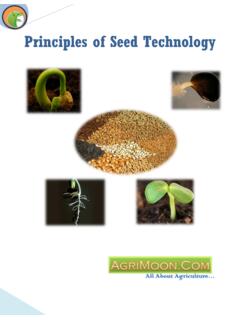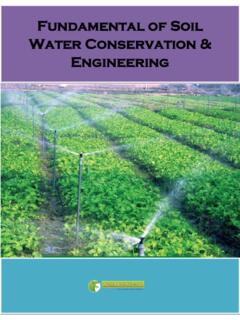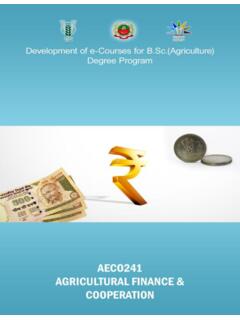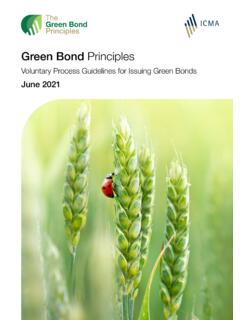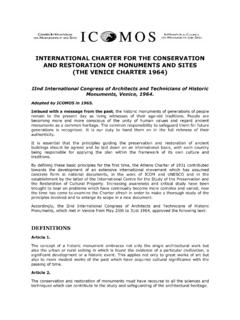Transcription of Fundamentals of Horticulture - AgriMoon
1 Fundamentals of Horticulture Dr. G. S. K. Swamy Dr. J. Auxcilia Fundamentals of Horticulture -: Course content creator :- Dr. G. S. K. Swamy Associate Professor (Fruit science) Kittur Rani Channamma College of Horticulture , Arabhavi -:Content moderater :- Dr. J. Auxcilia Assistant Professor (Fruit Crops) Horticulture College & Research Institute, TNAU, Coimbatore Index Lecture Name Page No Lecture Introduction 4-7 Lecture Horticultural crops and Human Nutrition 8-10 Lecture Climatic Requirement 11-15 Lecture Horticultural Zones of India 16-17 Lecture Soil Requirement 18-20 Lecture Importance of Nursery and its management 21-22 Lecture & 9 Planning of Orchard 23-25 Lecture Orchard 26-30 Lecture Kitchen garden 31-32 Lecture Digging and filling of pits 33-35 Lecture Orchard Management 36-46 Lecture No. 15 & 16 Water management 47-49 Lecture No.
2 17&18 Manures and manuring 50-54 Lecture No. 19 Weed management in Orchard 55-58 Lecture No. 20,21,22&23 Training and pruning 59-63 Lecture No. 24 &25 Kinds of flower bearing shoots (can it be clubbed with pruning in last chapter?) 64-67 Lecture No. 26 Top Working 68 Lecture No. 27&28 Problem of Unfruitfulness 69-73 Lecture No. 29 Organic farming 74-75 Lecture No. 30,31&32 Plant growth regulators 76-81 Lecture No. 33, 34 &35 Maturity indices for fruits 82-86 Lecture No. 36 Marketing of fruits (can this be dropped?) 87 Lecture INTRODUCTION India is the seventh largest country in the world with a total geographical area of m ha. and has second largest population 121crores (2011), after China. The total arable land available is 144 million hectare of which 70% is under rainfed cultivation. Around 55-60 per cent of the total population depends on agriculture and allied activities.
3 Horticulture crops constitute a significant portion of total agricultural production in the country. The term Horticulture is derived from the Latin words: hortus meaning garden and cultura meaning cultivation. In ancient days the gardens had protected enclosures with high walls or similar structures surrounding the houses. The enclosed places were used to grow fruit, vegetables, flowers and ornamental plants. Therefore, in original sense Horticulture refers to cultivation of garden plants within protected enclosures . At present the Horticulture may be defined as the science and technique of production, processing and merchandizing of fruits, vegetables, flowers, spices, plantations, medicinal and aromatic plants. Branches of Horticulture Horticulture is a wide field and includes a great variety and diversity of crops.
4 The science of Horticulture can be divided into several branches depending upon the crops it deals with. The following are the branches of Horticulture .. 1. Pomology: refers to cultivation of fruit crops. 2. Olericulture: refers to cultivation of vegetables. 3. Floriculture: refers to cultivation of flower crops. 4. Plantation crops: refers to cultivation of crops like coconut, arecanut, rubber, coffee, tea etc. 5. Spices crops: refers to cultivation of crops like, cardamom, pepper, nutmeg etc. 6. Medicinal and aromatic crops: deals with cultivation of medicinal and aromatic crops. 7. Post harvest technology: deals with post harvest handling, grading, packaging, storage, processing, value addition, marketing etc. of Horticulture crops. 8. Plant propagation: deals with propagation of plants. Fruit crops: India is the second largest producer of fruits after Brazil.
5 A large variety of fruit crops are grown in India. Of these, mango, banana, citrus, papaya, guava, pineapple, sapota, jackfruit, litchi, grapes, apple, pear, peach, plum, walnut etc. are the important ones. of Horticulture4 India accounts for 10 per cent of the total world production of fruits. It leads the world in the production of mango, banana, sapota and acid lime besides recording highest productivity in grape. The leading fruit growing states are Maharashtra, Karnataka, Andhra Pradesh, Bihar and Uttar Pradesh. Vegetable crops: More than 40 vegetables belonging to Solanaceaeous, cucurbitaceous, leguminous, cruciferous, root crops and leafy vegetables are grown in Indian tropical , sub-tropical and temperate regions. Important vegetables grown in India are onion, tomato, potato, brinjal, peas, beans, okra, chilli, cabbage, cauliflower, bottle gourd, cucumber, watermelon, carrot, radish etc.
6 India ranks second in vegetable production next to China in area and production contributing percent to the total world production. India occupies first position in cauliflower, second in Onion, third in cabbage in the world. West Bengal, Orissa, Uttar Pradesh, Bihar, Maharashtra, Karnataka are the important states for horticultural crop production. Floriculture: Flower cultivation is being practiced in India since ages. It is an important/integral part of socio-cultural and religious life of Indian people. It has taken a shape of industry in recent years. India is known for growing traditional flowers such as jasmine, marigold, chrysanthemum, tuberose, crossandra, aster, etc. Commercial cultivation of cut flowers like, rose, orchids, gladiolus, carnation, anthurium, gerbera is also being done.
7 The important flower growing states are Tamil Nadu, Karnataka, Andhra Pradesh, Maharashtra, West Bengal, Sikkim, Jammu &Kashmir, Meghalaya etc. Plantation crops: This is one of the important sector contributing about crores of export earnings. The major plantation crops include coconut, arecanut, oil palm, cashew, tea coffee, rubber cocoa, betel vine, vanilla etc. The leading states are Karnataka, Kerala, Tamil Nadu, Andhra Pradesh, Maharashtra, Goa, Assam etc. Spices: They constitute an important group of Horticulture crops and are defined as vegetable products or mixture thereof, free from extraneous matter used for flavouring, seasoning and imparting aroma in foods. India is known as home of spices producing a wide variety of spices like black pepper, cardamom, ginger, turmeric, chilli, Coriander etc.
8 Major spice producing states are Kerala, Andhra Pradesh, Gujarat, Rajasthan, Maharashtra, Karnataka, Orissa, Tamil Nadu etc. Medicinal and Aromatic plants: India has diverse collection of medicinal and aromatic plants species distributed throughout the country. It has more than 9500 species with medicinal properties. Demand for these crops is increasing progressively in both domestic and export markets. Important medicinal plants are Isabgol, Senna, Opium poppy, Periwinkle, Coleus, Ashwagandha, etc. and aromatic plants are Japanese mint, Lemon grass, Citronella, Davana, Patchouli etc. of Horticulture5 Features of Horticulture 1. Horticultural produces are mostly utilized in the fresh state and are highly perishable. 2. Horticultural crops need intensive cultivation requiring a large input of capital, labour and technology per unit area.
9 3. Cultural operations like propagation, training, pruning and harvesting are skilled and specific to horticultural crops. 4. Horticultural produce are rich sources of vitamins and minerals and alkaloids. 5. Aesthetic gratification is an exclusive phenomenon to horticultural science. Importance of Horticulture Horticulture is important for the following considerations: 1. As a source of variability in produce. 2. As a source of nutrients, vitamins, minerals, flavour, aroma, alkaloids, oleoresins, fibre, etc. 3. As a source of medicine. 4. As an economic proposition as they give higher returns per unit area in terms of energy, money, job, etc. 5. Employment generation 860 man days/annum for fruit crops as against 143 man days/annum for cereal crops and the crops like grapes, banana and pineapple need 1000- 2500 man days per annum.
10 6. Effective utilization of waste land through cultivation of hardy fruits and medicinal plants. 7. As a substitute of family income being component of home garden. 8. As a foreign exchange earner, has higher share compare to agriculture crops. 9. As an input for industry being amenable to processing, especially fruit and vegetable preservation industry. 10. Aesthetic consideration and protection of environment. 11. Religious significance. In short Horticulture supplies quality food for health and mind, more calories per unit area, develops better resources and yields higher returns per unit area. It also enhances land value and creates better purchasing power for those who are engaged in this industry. Therefore, Horticulture is important for health, wealth, hygiene and happiness. Scope of Horticulture Like any other things, scope of Horticulture depends on incentive it has for the farmers, adaptability of the crops, necessity and facilities for future growth through inputs availability and infrastructure for the distribution of produce/marketing etc.
